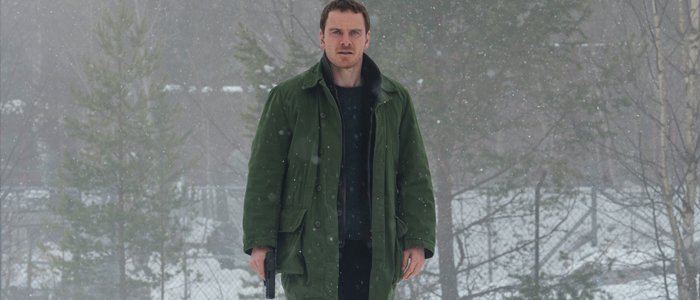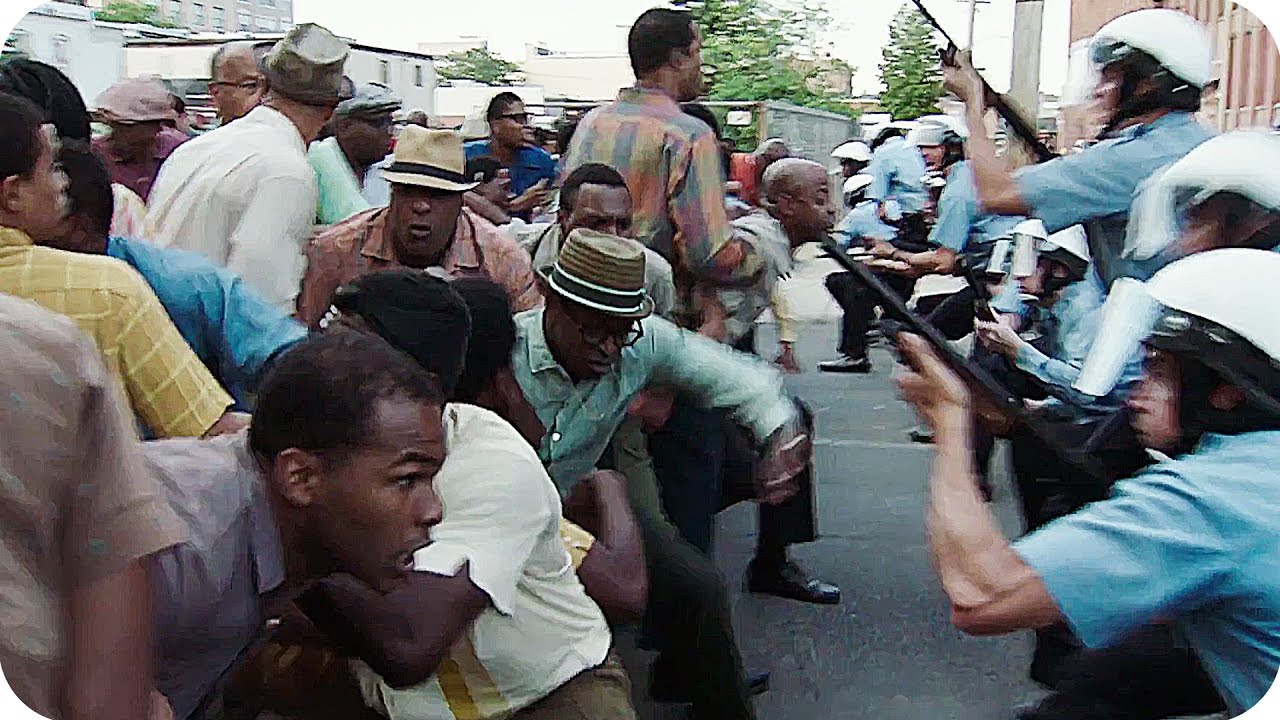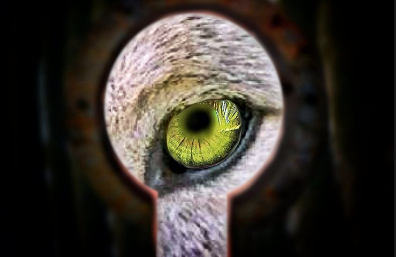Only now can it be told, six days later: I was watching TV last week when I decided to hit the kitchen in a hurry. I was in a slumping, nearly horizontal position on the big blue couch with my legs on the ottoman, so I bolted upright and began my journey. But the material covering the ottoman had been pushed off by Tatyana the night before, and somehow or other the material caught my right foot as I took my first stride. Right away my balance was gone as I began to stagger forward. Before I knew it I was completely off-balance and hurtling toward the dining-room table like George Foreman after that final punch from Muhammud Ali in Zaire. I landed on the right side of the table, causing it to tip over and with it all kinds of stuff — two laptops, a lamp, a coffee cup (shattered), charging wires, pen holders, a mouse pad, a bottle of computer-screen solvent, envelopes. After the table tipped I went with it, of course, and wound up on the floor. No wounds, no bruises, no dents. But Tatyana was watching with fascination and I felt a bit embarassed. Until the moment of impact I hadn’t caused that much domestic wreckage in my entire life.
 Jeffrey Wells
Jeffrey Wells
Should’ve Riffed On This Earlier
My bad for not highlighting this Snowman trailer last week or whenever the fuck it surfaced. You can tell this chilly British crime thriller is a standout, in part because you know director Tomas Alfredson (Let The Right One In, Tinker Tailor Solder Spy) has his shit together. Michael Fassbender, Rebecca Ferguson, Charlotte Gainsbourg, Val Kilmer, J. K. Simmons, Toby Jones, Chloë Sevigny. The Universal release opens on 10.20.17.
Detroit Broke My Heart
Kathryn Bigelow and Mark Boal‘s Detroit (Annapurna, 7.28 and 8.4) is a raw-capture history lesson hoping to arouse and enrage, but it mostly bludgeons. I’m saying this with a long face and heavy heart as I like and admire these enterprising filmmakers, but there’s no getting around the fact that they’ve made a brutal, draggy downer. Detroit lacks complexity and catharsis. It doesn’t breathe.
I was hoping that this blistering docudrama, which isn’t so much about the 1967 Detroit riots as the bloody Algiers Motel killings, would play like Gillo Pontecorvo‘s The Battle of Algiers, but alas, nope. Failing that I wanted Detroit to be an investigative political thriller in the vein of Costa Gavras‘s Z, but that wasn’t the scheme either.

No one is more beholden to Bigelow-Boal than myself; ditto their magnificent Zero Dark Thirty and The Hurt Locker. But after these two films I’ve become accustomed to brilliance from these guys, or certainly something sharper, leaner and more sure-footed than this newbie.
At best, Detroit is a hard-charging, suitably enraged revisiting of what any decent person would call an appallingly ugly incident in the midst of a mid ‘60s urban war zone. And of course the system allowed the bad guys to more or less skate or not really get punished. What else is new?
The Algiers Motel incident happened, all right, to the eternal discredit of Detroit law enforcement system back then. But guess what? It doesn’t serve as a basis for an especially gripping or even interesting film.
Detroit has good chaotic action, street frenzy, bang bang, punch punch and lots of anger, and I really didn’t like sitting through it and I watched it twice, for Chrissake. For they’ve made a very insistent but air-less indictment film — militant, hammer-ish, screwed-down and a bit suffocating.
In and of itself, the Algiers Motel incident repels but dramatically under-delivers. There’s not a lot of complexity in the portraying, although the episode obviously reflects upon several well-documented 21st Century instances of white-cop brutality and murder.
The white-guilt factor is abundantly earned in terms of the behavior of three pathetically brutal Keystone cops who also happen to be racist fucktards — Will Poulter‘s “Phillip Krauss”, Jack Reynor‘s “Demens” and Ben O’Toole‘s “Flynn”. But it needed more than this.
Ugly, blatant racism in and of itself is obviously repellent, but Detroit doesn’t feel sufficiently layered. It makes for a jarring but rather one-note movie.
The principal actors portraying the victims of harassment — John Boyega as Melvin Dismukes, Algee Smith as Larry Reed, Anthony Mackie as Greene — hold their own; ditto those portraying the shooting victims — Jason Mitchell as Carl Cooper, Nathan Davis, Jr. as Aubrey Pollard and Jacob Latimore as Fred Temple.
I can’t think of a single good sticker line — a line in the vein of Al Pacino‘s greatest Heat moments, say — or anything in the way of clever, diversionary movie craftsmanship. The Detroit script barely feels “written” in the sense that any number of urban thrillers have been. It doesn’t feel tightly sprung or strategized as much as thrown at the wall.

Too often the film feels coarse, pushed, misshapen, misjudged. I plainly, simply didn’t like watching it.
I didn’t even like Barry Aykroyd‘s photography — way too many tight close-ups. And if you ask me the cop haircuts feel a wee bit too long for ’67, when straight-laced society was still rocking short hair and whitewalls. Longish hair (hint of sideburns) didn’t sink into mainstream society until ’69 or ’70 or ’71.
It feels like a decent if rudimentary attempt to recreate the Detroit chaos of ’67 rather than some wowser re-visiting or, you know, a major redefining or rejuvenation of same.
Yes, there are four or five uniformed law enforcement figures plus a nurse (played by Jennifer Ehle) who come off as decent human beings, but otherwise the idea seems to have been to remove any and all shading, dimension and subtlety as far as the white characters are concerned. After a while your spirit wilts in the face of this diseased, cut-and-dried cardboard slime factor.
I’m not saying that white Detroit beat cops were anything but foul and deplorable for the most part back in ’67 (as many cops have recently shown themselves to be when it comes to treatment of black suspects in God knows how many altercations in recent years), but a movie of this sort has to deliver some kind of balance and finesse and shared humanity and quiet-down moments (i.e., we’re all scared children running around on God’s blue planet) or it’s just crude caricature — a racial hit piece.
Whatever the content or mood or metaphorical thrust, all good movies have to feel cinematically sexy. You have to be charmed by their chops, aroused by their strategy. If a movie doesn’t turn you on in one way or another or doesn’t at least make you sit up in your seat, it probably isn’t very good.
I could’ve rolled with Detroit if it had felt more slick and “commercial.” If only it had the look and professional cutting and smooth camerawork and assured pacing of Alan Parker’s Mississippi Burning. Yes, I know — an absurdly inaccurate film history-wise, but a very good one in terms of chops, and a damn sight better than Detroit in this respect. Remember the repetitive hammer music in Parker’s film? Not very melodic but it really worked, really connected.
Detroit makes its points but it’s direct and blunt to a fault. The attack on the bin Laden compound finale in Zero Dark Thirty was 11 or 12 times better than anything in Detroit. Ditto that lively firefight involving Ralph Fiennes’ character in The Hurt Locker.
What happened to the smooth, fleet editing, and the sense of planted authority and versimilitude that I got from Zero Dark Thirty and The Hurt Locker? I’ll tell you what’s happened to it. It’s taken a powder.
Rarely Spoken Of Since
My reaction to Lewis John Carlino‘s The Sailor Who Feel From From Grace With The Sea after catching it at a Westport cinema in ’77 was “nice try but not quite.” The young kid’s (Jonathan Kahn) homoerotic fixation with Kris Kirstofferson‘s sailor character synched with the 1963 Yukio Mishima source novel, but the ritualized killing at the end didn’t synch with the English setting and American sensibilities of the film itself. It felt pushed. But the sex scenes between Kristofferson and Sarah Miles were fairly hot, so at least there was that. Word around the campfire was that Miles and Kristofferson were entwined during shooting, and that this affair (coupled with an erotic Playboy spread they they both posed for) ended Kristofferson’s marriage to Rita Coolidge. That was the rumble, at least. Yes, the Bluray has been out for ages. No, I haven’t bought it.
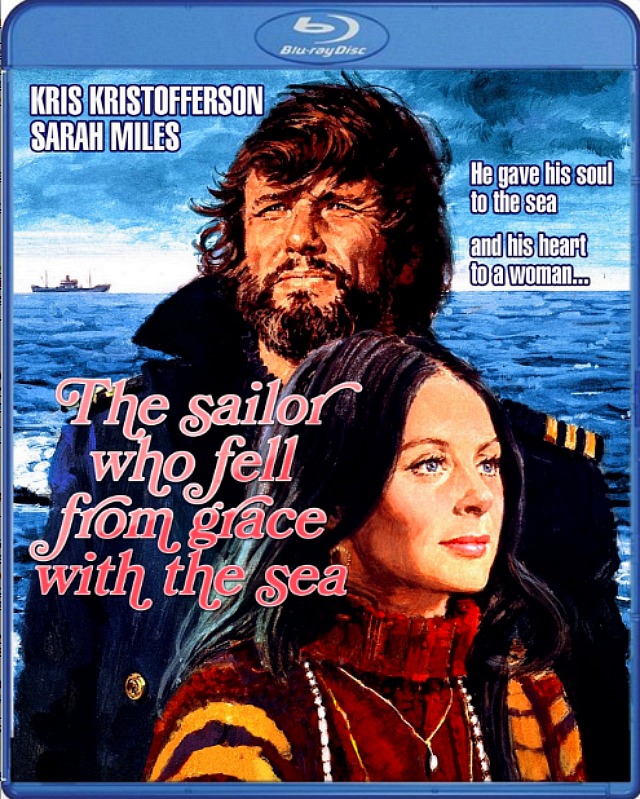
YA Nightmare: Spielberg Channelling Bay
In Steven Spielberg‘s adaptation of Ernest Cline‘s futuristic Ready Player One, Wade Watts (Tye Sheridan) “searches for an easter egg in a virtual reality game, the discovery of which will lead him to inherit a valuable fortune in a world torn by an energy crisis” blah blah. But before anything triumphant can happen, Wade has to grapple with bad-buy Nolan Sorrento, played by HE’s own Ben Mendelsohn. Plus Spielberg mainstay Mark Rylance in a significant dual role. Screenplay by Cline and Zak Penn.
“Dextrous Temporal Elasticity”
If you’ve seen Dunkirk or read the reviews you know about the land-sea-air thing. The Guardian‘s Mark Kermode has explained the scheme, at least as he sees it:
“Ingeniously, these strands play out over three different time periods; one week, one day and one hour respectively. As the stories interlace, with boats, boots and planes converging at Dunkirk, so time itself is variously compressed and elongated in Inception-like loops, conjuring shifts and reversals as complex — yet still crucially as clear — as those of Nolan’s 2000 psychological thriller Memento. For all its visual splendor, Dunkirk is a masterclass in dextrous temporal elasticity, a recurrent theme for Nolan, sparked by his love of Graham Swift’s novel “Waterland” and explored most recently in Interstellar.”
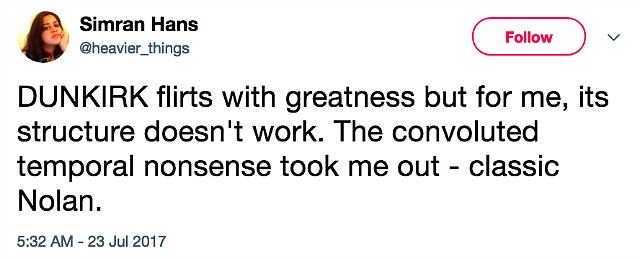
“Real People Hide”
“People do not necessarily reveal what is going on — only bad actors do. Bad actors try to cry, and good actors try not to. Bad actors try to laugh, and good actors try not to. Only bad actors play drunk. Good actors play drunks playing sober! They don’t want everyone in the room to know they’re drunk, and if you’ve ever seen a drunk pick up a glass to his mouth at a bar, it’s the most studied, controlled thing you’d ever see, as opposed to the sloppy kinds of drunks you see played everywhere. There’s a real amount of bad acting around that is considered good acting, and I see at the Actors Studio every week stuff that far excels what I see on Broadway or television or film.” — shared by the late Martin Landau in 2010. Quote stolen from 7.21 Kim Morgan piece.
Troublemakers
During the chilly months you’ll occasionally daydream about the languid comforts of hot summer afternoons, but when they actually arrive you never seem to savor them. Mostly because you’re avoiding the heat in some air-conditioned space, at home or more often in a car and at the same time thinking “I can’t say I’m actually enjoying this…it would be nicer to be slightly sweating outside somewhere.”
We drove up to sun-baked Goleta yesterday afternoon, and most of the time I was trying — struggling — to suppress hostile thoughts about other drivers. The wisest approach to freeway driving is to blend in and go with the flow. Don’t drive faster than your fellows and make an extra-special point of not driving slower. For three-plus hours I was grappling with God knows how many drivers who couldn’t have cared less about this simple rule of civilized behavior. Especially those who couldn’t seem to understand that if they wanted to drive slower they needed to pull into the right lane. More considerate that way, but in the minds of too many it didn’t register. Hell is other people.
Hour of the Wolf
It’s not a great idea to meditate too heavily upon basic “where is my life heading?” stuff if you happen to be up at 4:30 am, as I was a little while ago. I tried to concentrate on my usual pre-dawn iPhone surfing ritual, searching for stories or topics or bounce-offs that might be worth a comment or argument of some kind. But that old, regrettably familiar Ingmar Bergman-like sense of impending doom kept creeping in. It’s best not to dwell in this realm. Gloom thoughts always go away when the morning light appears. But that vague sense of big black wolves sitting outside your door at 5:10 am…whoa. Why am I even sharing this? I can’t even remember if I’ve seen Hour of the Wolf, which probably means I haven’t. But I guess I don’t need to, right?
Time Of His Life
I can only hope that after I’m toast someone eulogizes me with an opening graph as good as this one. Hats off to Daniel Stern, whom I ran into once in Keith Szarabajka and Julie Donald‘s sprawling basement pad.


John Heard Fuming at Variety From Heaven
Shame on Variety and deputy editor Pat Saperstein for describing the late and great John Heard, who yesterday was found dead in a Palo Alto hotel room, as the “Home Alone dad.” Great merciful bloodstained gods! Why would Variety do such a thing to an actor of Heard’s calibre? This is like an obit headline writer calling James Stewart “the singing Magic of Lassie guy.”
Yes, Heard played Macaulay Culkin‘s dad in the hugely popular Home Alone (’90) and in the ’92 sequel, Home Alone 2: Lost in New York, but show a little decency, for God’s sake. Heard was glad to have starred in these films, but he did it for the money.

Heard should more properly be remembered and honored for his late ’70s to early ’80s hot streak of fierce, penetrating performances in Between The Lines, On the Yard, Chilly Scenes of Winter, Heart Beat (in which he played Jack Kerouac to Nick Nolte‘s Neal Casady), Ivan Passer‘s Cutter’s Way and Paul Schrader‘s Cat People, the only film in which Heard played a romantic lead.
And don’t forget his wonderful work on The Sopranos as that sad, corrupt, dessicated detective who was on Tony Soprano’s payroll and half-hated himself for that.
Heard downshifted into character roles after Cat People, but he scored in CHUD, Best Revenge, Martin Scorsese’s After Hours, The Trip to Bountiful and Robert Redford‘s The Milagro Beanfield War.
In the spring of ’83 I saw Heard knock it hard and straight in Total Abandon, a courthouse stage drama written by Larry Atlas. Or so I recall. I certainly remember going up to Heard after the matinee ended and saying “Wow, man…that’s a tough role to play twice a day” and him smiling and shrugging and saying “naaah, just a workout.”
I’m pretty sure I also saw Heard act in G.R. Point, an anti-war play set in Vietnam, but I need to sift through my memory leaves a bit more.

